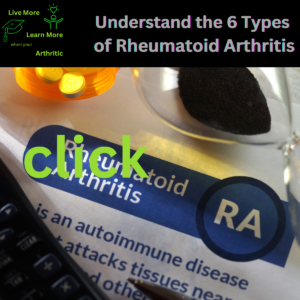
Rheumatoid Vasculitis: 3 of 6 Subtypes of Rheumatoid Arthritis (RA)
Unveiling Rheumatoid Vasculitis: A Journey of Resilience
Juvenile Rheumatoid is a rare and serious complication of Idiopathic Arthritis characterized by inflammation of blood vessels throughout the body. This condition can affect various organs and tissues, posing significant challenges for affected children and their families.
Read each of the 6 Rheumatoid Arthritis Subtypes.
6 Subtypes of Rheumatoid Arthritis
Seronegative Rheumatoid Arthritis (RA): 1 of 6 Subtypes of Rheumatoid Arthritis (RA)
Juvenile Rheumatoid Arthritis (JRA): 2 of 6 Subtypes of Rheumatoid Arthritis (RA)
Palindromic Rheumatism: 4 of 6 Subtypes of Rheumatoid Arthritis (RA)
Undifferentiated Connective Tissue Disease (UCTD): 5 of 6 Subtypes of Rheumatoid Arthritis (RA)
Seropositive Rheumatoid Arthritis: 6 of 6 Subtypes of Rheumatoid Arthritis (RA)
And the Rheumatoid Arthritis Severity Scale
 Embarking on the Journey of Rheumatoid Vasculitis: Navigating Challenges with Resilience
Embarking on the Journey of Rheumatoid Vasculitis: Navigating Challenges with Resilience
Step into the world of rheumatoid vasculitis, where the complexities of autoimmune conditions intersect with vascular health. Join us as we unravel the impact of this condition on the body and explore avenues for proactive management.
The Body’s Battleground: Understanding Affected Areas
Rheumatoid vasculitis primarily affects small and medium-sized blood vessels, potentially impacting various organs and tissues, including the skin, nerves, and internal organs. The inflammatory response targets blood vessel walls, leading to damage and compromised circulation.
Pursuing Remission: The Spectrum of Disease Activity
Can rheumatoid vasculitis achieve remission? With aggressive treatment targeting underlying rheumatoid arthritis (RA) and associated inflammation, remission is possible. However, relapses can occur, necessitating ongoing monitoring and therapy adjustments.
Decoding the Disorder: Causes and Triggers of Vasculitis
What initiates rheumatoid vasculitis? This condition is a rare complication of RA, characterized by immune-mediated inflammation affecting blood vessels. Genetic predisposition and chronic inflammation in RA contribute to its development.
Symptoms Unveiled: Navigating the Clinical Landscape
How does rheumatoid vasculitis present? Symptoms vary based on affected organs but may include skin ulcers, nerve pain or numbness, abdominal pain, and muscle weakness. Joint involvement can lead to stiffness and limited range of motion.
Onset and Prognosis: The Age Spectrum and Lifespan Considerations
When does rheumatoid vasculitis typically emerge? It often manifests in individuals with longstanding RA, typically in their 50s or older. The condition may lead to complications that impact life expectancy, emphasizing the importance of comprehensive management.
Autoimmune Insights: Unraveling the Immunological Connection
Is rheumatoid vasculitis an autoimmune form of arthritis? Yes, it stems from immune system dysfunction seen in RA, where autoantibodies attack healthy tissues, including blood vessels.
Risk Factors Unveiled: Identifying Vulnerabilities
Who’s at risk of developing rheumatoid vasculitis? Individuals with severe, longstanding RA are more susceptible. Factors like smoking, genetic predisposition, and uncontrolled inflammation increase the risk.
Complications Chronicle: The Cascade of Health Challenges
What are the complications of rheumatoid vasculitis? They range from skin ulcers and nerve damage to potentially life-threatening conditions like organ failure due to compromised blood flow. Joint deformities and limited mobility can also occur.
The Inflammatory Impact: Understanding Swelling and Pain
Is inflammation a driving force in rheumatoid vasculitis? Absolutely. Inflammatory processes within blood vessels lead to swelling and pain, contributing to tissue damage and dysfunction.
Joint Tenderness and Dysfunction: The Role of Rheumatoid Arthritis
Does joint tenderness accompany vasculitis? Yes, joint inflammation and damage in RA can exacerbate symptoms, affecting mobility and range of motion.
Cartilage Considerations: Impact on Joint Integrity
How does rheumatoid vasculitis affect cartilage? Persistent inflammation can erode cartilage, leading to joint deformities and functional impairments.
Comorbidity Complexities: Recognizing Associated Conditions
Are there interconnected diseases to be aware of? RA-related conditions like Sjögren’s syndrome, interstitial lung disease, or cardiovascular complications may coexist, necessitating a multidisciplinary approach to care.
Embracing Proactive Management: Enhancing Quality of Life
Can a proactive approach improve life with rheumatoid vasculitis? Yes. Regular medical monitoring, aggressive RA management, physical therapy, and lifestyle modifications can optimize outcomes and mitigate complications.
Complications Explored: Anticipating Challenges
What are the potential complications of untreated or poorly managed vasculitis? Skin ulcers, nerve damage, organ dysfunction, and mobility limitations can significantly impact quality of life and overall health.
Demographic Dimensions: Gender and Age Dynamics
Who’s most affected by rheumatoid vasculitis? It’s more prevalent in women with longstanding RA, typically appearing in middle to older age due to the cumulative effects of chronic inflammation.
Interconnected Health Realities: Considering Coexisting Conditions
Are there related diseases to consider? Vasculitis may coexist with systemic autoimmune disorders like lupus or systemic sclerosis, underscoring the need for comprehensive disease assessments.
In conclusion, while rheumatoid vasculitis presents formidable challenges, proactive management and comprehensive care strategies can optimize quality of life and mitigate complications. Each step towards understanding and proactive intervention offers hope and resilience in the face of autoimmune complexities, illuminating pathways towards health restoration and renewed vitality.

